Kentwell costuming – The Petticoate – Children version
Just remind that for costume making I will be following the tudor costume page fairly slavishly the tudor tailor book and nearer the time costume elves [!] for the difficult bits I am currently not a re-enactor, but have visited Kentwell [see preamble] and we are really keen as a family to join the tudors. I plan to make a shift and petticoat for each of us girls, a shift for DH by Xmas, and 2 shifts each before the first open day in feb [ie majority of linens, at my own risk as may well not be accepted] this is because there is a huge amount of sewing to be done, and i think if you are any more than 2, to try and fit it all in after acceptance is really a tall order and hard work.
This means that the steps detailed here are not originating from my brain, but the tudor costume makers, though some of the mistakes and how to avoid unfortunately did :blush: . The tudor costume page has unfortunately got some non-working links, and since it was last updated a fair while ago there are a few non-completed bits. This wasn’t a problem for petticoates though. Nothing detailed here seems particularly at odds with costume notes from a prev year.
Anyone thinking of making clothes for re-enactment, please check with your group the ‘rules’ on materials, colours and look. different tudor years have different styles – tho less so for poor, especially poor kids. following these notes does not guarentee acceptance of clothing by Kentwell or any other group, but may help a total novice such as myself. I had never made any clothes before these – a hint of my novicitude. I wrote this initially in Sept 2011, but have added in the things that had I had known I would have done differently – mostly in italics ![]()
The Materials:
I have used a drabbish blue 100% pure linen shirting material. I have used cotton thread though, even if linen more authentic in a near matching greyish colour. I washed it and dried it as recommended
*it has to be said, that there isn’t necessarily huge evidence for coloured linen petticoats in a lot of tudor texts, there is definitely evidence for lighter red wool ones tho, and red is a good colour for a petticoat. If making in advance and playing safe, an unbleached linen or red wool, and then you can dye the linen if it is deemed acceptable by the kentwell year you go to, or by the tudor group you join. Also, that this prob should have a bodice on it. so it prob is a half kirtle in linen – yes, the terminology for me still goes above my head ![]() however, currently a petticoat/half kirtle call it what you will in coloured linen is acceptable for kentwell as an underlayer. It is not essential but useful so you can lift up your woolen kirtle so it doesnt get covered in mud*
however, currently a petticoat/half kirtle call it what you will in coloured linen is acceptable for kentwell as an underlayer. It is not essential but useful so you can lift up your woolen kirtle so it doesnt get covered in mud*
The Disclaimer[s]:
the only bit of clothing i have ever otherwise made is a victorian pinny last year with sewing machine. I am a complete novice with any kind of stitching at all. I find it near impossible to follow a pattern and have a strong allergy to straight lines, accurately measuring and cutting and all those other things that make successful dressmakers. I have never been to Kentwell as a re-enactor, so my attempts are as yet unapproved at costume check! ie follow my lead at your peril ![]()
Having said that, the Tudor costume appears to have had all her designs accepted at Kentwell, so I am hopeful. So, opening the page to petticoats…
[clearly I did pass costume check ![]() . but what i would now like to add having done Kentwell, is that really really reinforce the sewing to the waistband, if hand sewing double the thread, if machine go over twice! and for your childr make no longer than midcalf for they will always be treading on it. if you are aiming for room to grow, have a small hem, but 4-5 inches above do a tuck of about 2-3 inches of material ]
. but what i would now like to add having done Kentwell, is that really really reinforce the sewing to the waistband, if hand sewing double the thread, if machine go over twice! and for your childr make no longer than midcalf for they will always be treading on it. if you are aiming for room to grow, have a small hem, but 4-5 inches above do a tuck of about 2-3 inches of material ]
Measuring Up:
I read the rectangle bit and thought hmmm so what does that mean in terms of widths and lengths for a child then? my material was 50inches wide and my child 23inches all round and 36 inches to just above ankle. so I decided to go for the version where it says have 2 rectangles so they were each 50 inches wide and 40 inches long – ie a multiplication factor of 4 of the waist measurement. *I think this is quite generous now, and think you could prob get away with a x2.5 -3 facto with a maximum of 1m each.*
So having made that decision for SB, I decided to do the version at the bottom of the tudor costume page which allows for pregnancy etc. obviously at 10 this isn’t n issue [phew!] but did want to factor in some growth.
Cutting and Hemming the Rectangles:
I didn’t cut the straightest of lines, but hemming made the rectangles pretty acceptable standard, and they did appear to be of similar length and width also – always a relief! I did decide to handstitch all, and go with the suggested option of hemming the seams and then whipstitching later, though a bit tempted by run and fell for the imaginative title of a stitch ![]() . *hemming and whipstitching a good option – it allows you to add panels easily later, but the hemming keeps the linen edge ‘hidden’ and as it loves fraying, this is a good thing
. *hemming and whipstitching a good option – it allows you to add panels easily later, but the hemming keeps the linen edge ‘hidden’ and as it loves fraying, this is a good thing ![]() this is called a finished seam I believe*
this is called a finished seam I believe*
Proudly looking at my completely hemmed rectangles I re-read the instructions and realised that it hasn’t mentioned hemming yet. So, to do again, I would still hem at this point, but the short sides only ![]() Definitely do not hem what will be the top. Although nice and neat, think that the waistband is now fairly bulky due to all the material stuffed in it. Oh, I think i forgot to say in the disclaimers that I also have an aversion to undoing and redoing unless absolutely have to. I have decided this top hem is ‘spare length for the future’ though imagine i will never unpick it! A further band round the bottom would be easier. *and actually in keeping with period – TBH placket a good idea for waist stretching, but really don’t be bothered about length for the future – tudors not into big hems as materials cost money, and the skirt can get shorter over the year, and eventually put a band around the bottom *
Definitely do not hem what will be the top. Although nice and neat, think that the waistband is now fairly bulky due to all the material stuffed in it. Oh, I think i forgot to say in the disclaimers that I also have an aversion to undoing and redoing unless absolutely have to. I have decided this top hem is ‘spare length for the future’ though imagine i will never unpick it! A further band round the bottom would be easier. *and actually in keeping with period – TBH placket a good idea for waist stretching, but really don’t be bothered about length for the future – tudors not into big hems as materials cost money, and the skirt can get shorter over the year, and eventually put a band around the bottom *
Preparing the Waistband:
i did actually measure this a lot more carefully! I have 2 waistband halves: the front and the back. each was measured out at 14 inches by 4 inches, with the plan to have a 12 inch by 1 inch band at the end. however, having prepared one, I thought that I would make the other so it was 13 by 1 inch to give a bit more breathing room after putting the 2 12 inch ones around sb. SInce i had included plenty of hem allowance in the cutting, this was very easy. [the costume notes suggest making your waistband 5” longer, i am not sure why? or is it to waistband the placket? I didn’t anyway, and it seems to have worked nicely.
I did all the folds as in the tudor costume page, and then had a crisis and couldn’t overcome my natural disinclination to use an iron. Linen seems to fold well anyway. I did, however, mark the pleats with pen as that seemed very sensible. Due to the voluminous amount of material [hence suggesting a x3 multiplier is more than adequate, and in truth a max of 2m all round] i spaced the pleats at 2cm.
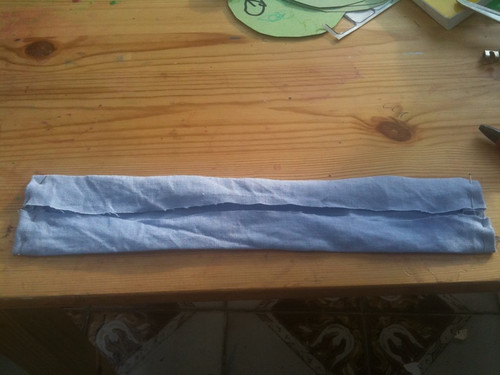
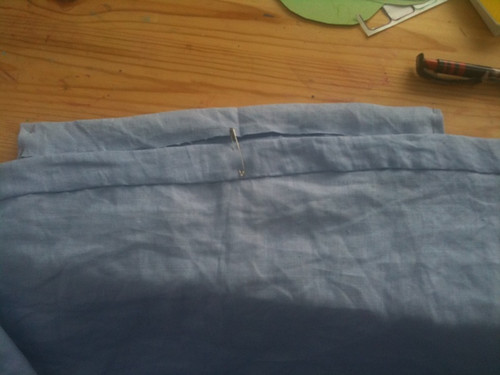
Pinning the Pleats:
You can see in the picture above I safety pinned for reference the centre of my waistband and the centre of the skirt together before starting pinning so all was even. I had knife pleats going away from a central point and each pleat went back to the previous one before going ahead the next 2cm ie 4cm forwards and 2cm back, 4 cm forwards etc to space at 2cm. this left me with 3inches of free material on each side of the front 12 inch waistband, which are the plackets for the extendible nature of the petticoate. For the rear 13 inch waistband I did some minor bodging so that it fitted. Tudor petticoats at this time have a central unpleated section at the front and knife pleat all the way around to the back, where they meet as a box pleat.
When I pinned these down, I pinned both the forward turn of the pleat and also the backwards return. please have all your pinheads to the upper rather than heads down. It will make it a lot easier to remove them after stitching!
I then looked critically at both bits, decided I was happy, draped them round a v complaining SB even tho pins were outside as it did look scary [30 pins in each bit] and made sure that it seemed a nice tight fit as since it has extension room, didn’t want it to start too loose! Realised this style accentuates her slimness and felt a pang of jealousy [must do better at diet] . You can see the will-be-placket in one of the pictures
Sewing the Skirt to the Waistband:
I have to say that here I am not entirely sure I have followed instructions. i have hemmed the waistband onto the pleats on the outside as I think it suggests, and then decided just to hem the other side might be a bit weak, especially for a child who will run and trip up etc. SO after hemming the good side, on turning back over I did a running stitch between the pleats and the fold up of the waistband, so invisible from the outside, but hopefully a bit of extra strength.
I removed all the pins – including those lost in the folds because their heads were down – ouch – and hemmed the inside view waistband to pleats. It does look v neat and good [for me] and I am pleased. The waistband is chunky though, due to the unfortuate hemming of all sides thing. Might not be a bad thing though, as won’t ruckle up so much. ou cans see the thickness and the sewing through in one of the pictures.
- Whipstitching the Sides:
This was a nice easy job. from the internet it looks like whipstitching is the same as in patchwork, so that is what i have done all up both seams to the very top, so the placket on each side – which is effectively straight rather than placket shaped ![]() – is joining the front and the back. It has 3 inches expansion and SB could easily slip over her hips [and when she can’t i will just free the placket from the back…
– is joining the front and the back. It has 3 inches expansion and SB could easily slip over her hips [and when she can’t i will just free the placket from the back…
i would have been delighted except… it is about 1.5 inches from being a snug waist fit ![]() ie that extra inch wasn’t required. Ho Hum. She has a 6 month to grow before trying it on for real, so maybe will need some of that inch. The length is just right for now, as she is bound to have a couple more inches of height.
ie that extra inch wasn’t required. Ho Hum. She has a 6 month to grow before trying it on for real, so maybe will need some of that inch. The length is just right for now, as she is bound to have a couple more inches of height.
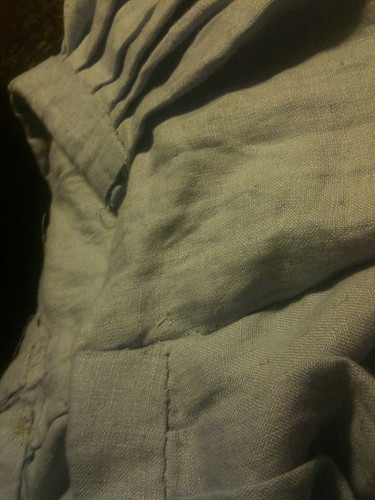
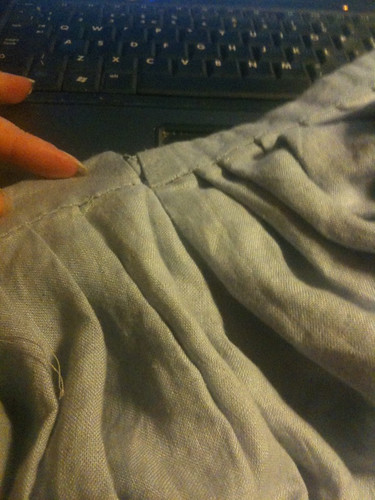
you can see the placket open and closed above
- Making the Linen Ties:
I decided i would have them 1cm wide so cut 2 inches wide and the length of the waistband long. Initially I did it as per the tudor Costume, sewed inside out and attempted a pull through, it did fine till half way when my thread snapped.
I decided to bail out, and did the fold as per waistband [fold each edge into the middle] and did a neat running stitch all along. I think it looks fine . I have then sewed them onto the waistband, recessed along by 3 inches, and since these stitches would be visible, decided to make them v slightly decorative. I think it looks good, will hopefully hold firm, and will scrunch up the sides perhaps 1/2 inch each side, so take most of the spare out. Very happy with the end result. SOme of the seams etc could have been neater, I have definately learnt from the process so the next should be benefitting from this. Alternativeoy, a hook and eye fastening is fine.
What it needs now is a bit of a tidy and neaten job in a few places, and a try on by SB, and then I would iron it and put it away if i was an ironer. Instead I will hang it in the wardrobe and move onto the next petticoat. But, as the first item of clothing I have ever sewn, I am inordinately proud of myself ![]()

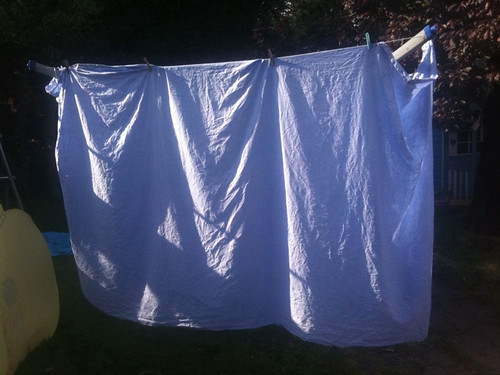
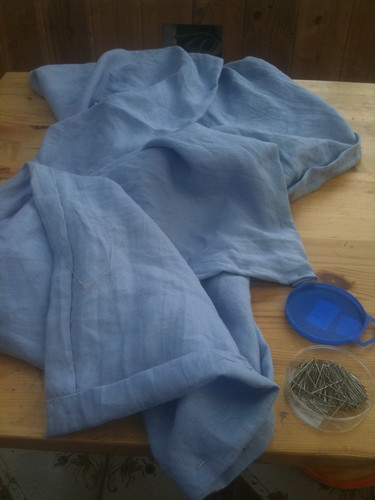
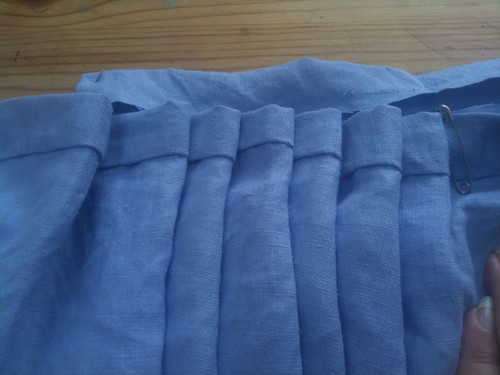
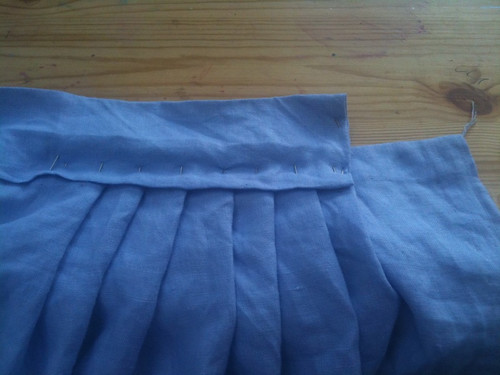
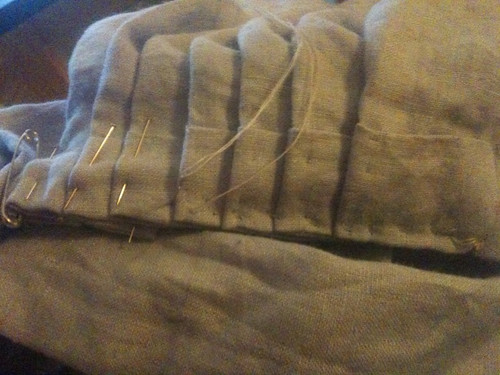
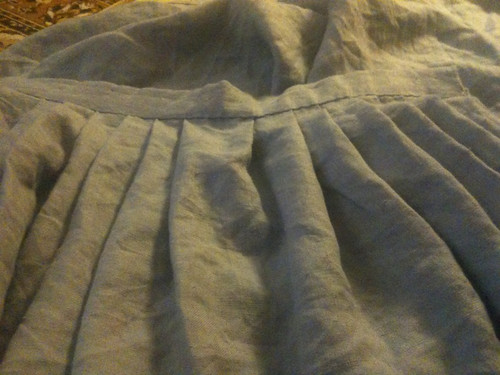
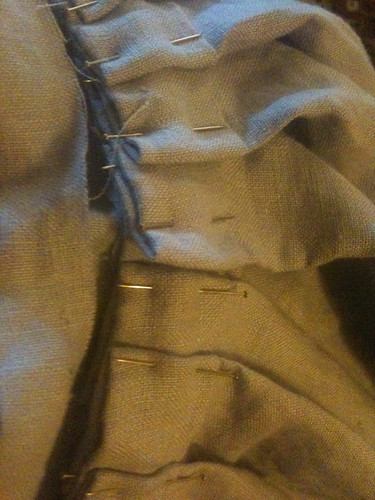
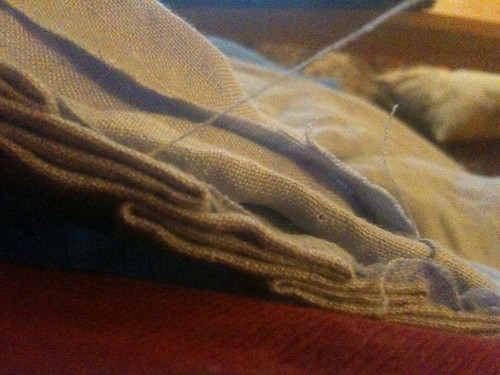

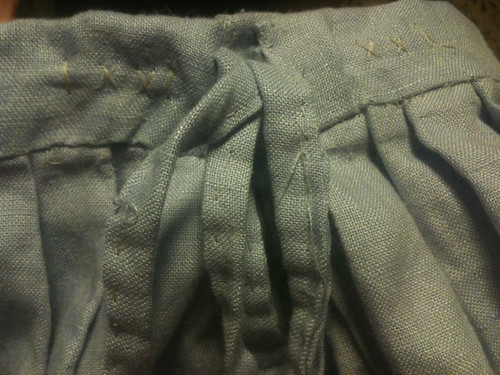

very impressed!
I’m impressed too. In awe, in fact.
(and also very glad that we live so far from Kentwell that I couldn’t even possibly consider going because even if I did consider taking part I wouldn’t be able to sew costumes and then I wouldn’t be able to after all …)
Well done though – I’m sure you will all really enjoy it